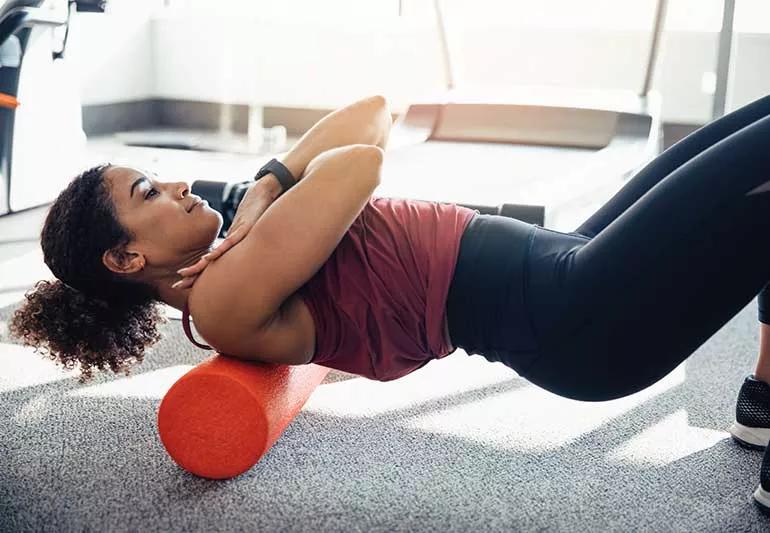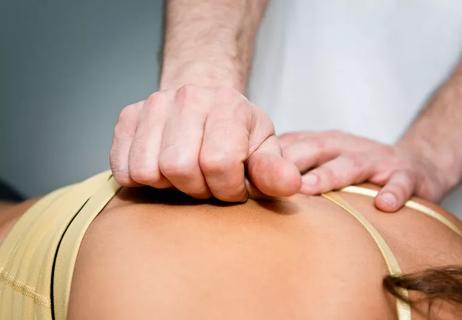This self-myofascial release technique can help ease sore or achy muscles

Exercise can lead to sore, achy muscles. But foam rolling can be a useful strategy when it comes to warming up before a workout or cooling down after a sweat session.
Advertisement
Cleveland Clinic is a non-profit academic medical center. Advertising on our site helps support our mission. We do not endorse non-Cleveland Clinic products or services. Policy
By using a lightweight cylindrical tube made of dense foam (some resemble a pool noodle), you can roll over tight spots (think your upper back, quads and calves) to help reduce muscle soreness and inflammation.
So, how do you foam roll? And is it safe? Exercise specialist Ben Kuharik rolls us through the motions and explains why foam rolling is a good step to add to your routine.
Considered a self-myofascial release (SMR) technique, foam rolling is when you use a foam tube to alleviate muscle tightness, soreness and inflammation. It can also help improve your range of motion.
Myofascial release helps manage pain and discomfort by applying pressure to areas that are tight or sore to help them relax.
By using a foam roller, you can apply pressure and massage the area by rolling the tool back and forth. This can be helpful before you start a workout.
“Foam rolling primes the muscles and gets your neuromuscular activation going,” says Kuharik. “Which means it helps to strengthen the connection between the brain and muscles.”
And that connection not only helps your brain key in on which muscles to focus on, but foam rolling also helps lengthen your muscles.
“You want as much length as you can when you’re exercising so you don’t compensate and use other muscle groups in place of what you’re trying to target,” explains Kuharik.
Advertisement
When it comes to your post-workout, foam rolling also plays an important role. Many people who exercise experience post-workout soreness and tightness. Using a foam roller after your workout may help with acute pain relief, but what about delayed onset muscle soreness (DOMS)?
Research is thin on whether it can help prevent DOMS, pain that starts a day or two after a workout.
“Using a foam roller is similar to when you get a massage, you usually feel better afterward,” says Kuharik. “You feel great and it allows you to move around a little bit more. Then, the more you move, the more the blood starts to flow through your muscles. But foam rolling hasn’t been proven to help with DOMS.”
Even if you don’t exercise, foam rolling can be helpful for people who sit at a desk or stand all day. Foam roller benefits include:
“If you stretch out a cold muscle, you’re more likely to injure it,” explains Kuharik. “So, if you want to use a foam roller whenever you’re warming up and get more blood flow to the area, you’re less likely for injury.”
And while foam rolling has been touted as a way to improve the appearance of cellulite, there’s no real evidence of this.
“There’s some people who think that blood flowing to the area can change the appearance of their body somehow,” notes Kuharik. “But foam rolling doesn’t have any major effects like that. The main benefits are helping elongate the muscles and provide acute soreness relief.”
Yes, foam rolling is generally safe. But if you have a broken bone or a torn muscle, you’ll want to speak with your doctor first. You also want to be careful about using a foam roller on joints like your ankles, knees or elbows, as it can cause you to hyperextend those areas.
And if you’re pregnant, foam rolling can help with sore muscles and provide relaxation. But Kuharik says it’s best to talk to your healthcare provider first.
You can find foam rollers in stores and online. And you can pick different sizes (even ball-shaped rollers that are great for working on sore muscles between your shoulders) and firmness of the foam.
While most foam rollers have a smooth surface, you can also find options that have a textured exterior, which is good for working on deep knots and tension.
Most gyms or workout facilities will have a variety of foam rollers so you can test out which ones work best for you before purchasing your own.
Advertisement
“Some people prefer using a softer foam roller — it’s also good for beginners,” states Kuharik. “People who are avid runners or workout frequently tend to pick ones with a firmer foam.”
Using a foam roller can be a great way to help prep your muscles before a workout and to help recover afterward. And it’s something those who work in front of a computer or stand at work all day can use as well. So, basically, it can be a good tool for almost anyone.
And if you feel overwhelmed by all the different ways you can use a foam roller, you’re not alone.
“Many people feel like they’re not using it correctly because there’s many variations of foam rollers and many different ways to use them,” says Kuharik. “But remember that there’s no one perfect way to do it.”
To get started, Kuharik suggests using a lightweight, smooth foam roller. You can use a foam roller at any point in the day, but he recommends using it in the morning.
“Spend about one to two minutes per muscle group or area where you’re feeling sore or stiff,” he says.
While foam rolling can help with pain, many who use a foam roller may experience pain and discomfort when they roll over certain muscles or areas. These trigger points mean that the muscle you’re working on is stuck in a contracted position.
Advertisement
“Just putting that pressure on it helps release any tension,” says Kuharik. “The pain can be intense. But by working on the spot with a foam roller, you’re able to relax and feel better.”
If you hit a tender spot, he says it’s best to adjust the pressure and work around the sore area first before returning to that spot.
“Start out light — don’t put your whole body weight into it right away,” he continues. “You want to find your tolerance then adjust if you’re sore from it the next day.”
Once you find a sore spot, you want to roll slowly and take a deep breaths in through your nose, out of your mouth. You can repeat the move about three to five times.
You can use a foam roller daily or a few times a week — whatever works best for you. It all depends too on how many areas you’re working on.
“If you’re just hitting one muscle area, you won’t have to spend more than three minutes doing it at a time,” says Kuharik.
Overall, he adds that foam rolling shouldn’t take more than 10 minutes. “It doesn’t take a lot of time but it can provide a lot of benefits.”
Can you use a foam roller for back issues or foam roller stretches for your hamstrings? Yes! While there are countless ways to use your foam roller, Kuharik explains a few popular moves:
Advertisement
Overall, whether you use a foam roller is up to you. If you’re experiencing muscle soreness after working out or if you just want to get a good massage in after sitting at your desk all day, a foam roller can be a good way to help alleviate any tightness or pain.
“Everybody finds at least some benefit when they use a foam roller,” reassures Kuharik. “Different people prefer certain modalities over others. It’s not a necessary tool, but it does provide benefits that you can’t find elsewhere.”
Learn more about our editorial process.
Advertisement

Use this hands-on approach to manage pain and discomfort

This gentle yoga stretch supports your spine, strengthens your core and calms your mind

Shoulder rolls, hamstring stretches and calf exercises can all improve flexibility and endurance

Physical activity can help preserve and improve your cognitive function and fend off dementia, stroke and other health concerns

Lower-intensity workouts can deliver high-quality health and fitness results

Incremental changes in your exercise routine can improve your strength and endurance over time

Understanding heart rate zones can help you tailor your workout to reach your goals

Increase the size of your muscles by bulking up on protein and focusing on slow, intense movements with progressive overloading

Babies can get congested easily, but you can calm their cough by keeping them hydrated, using nasal drops and running a humidifier

Weight loss may cause loose, sagging skin and muscle loss to your rear

Several conditions, like vitiligo and fungal infection, can cause a loss of pigmentation, leading to white spots or patches on your skin